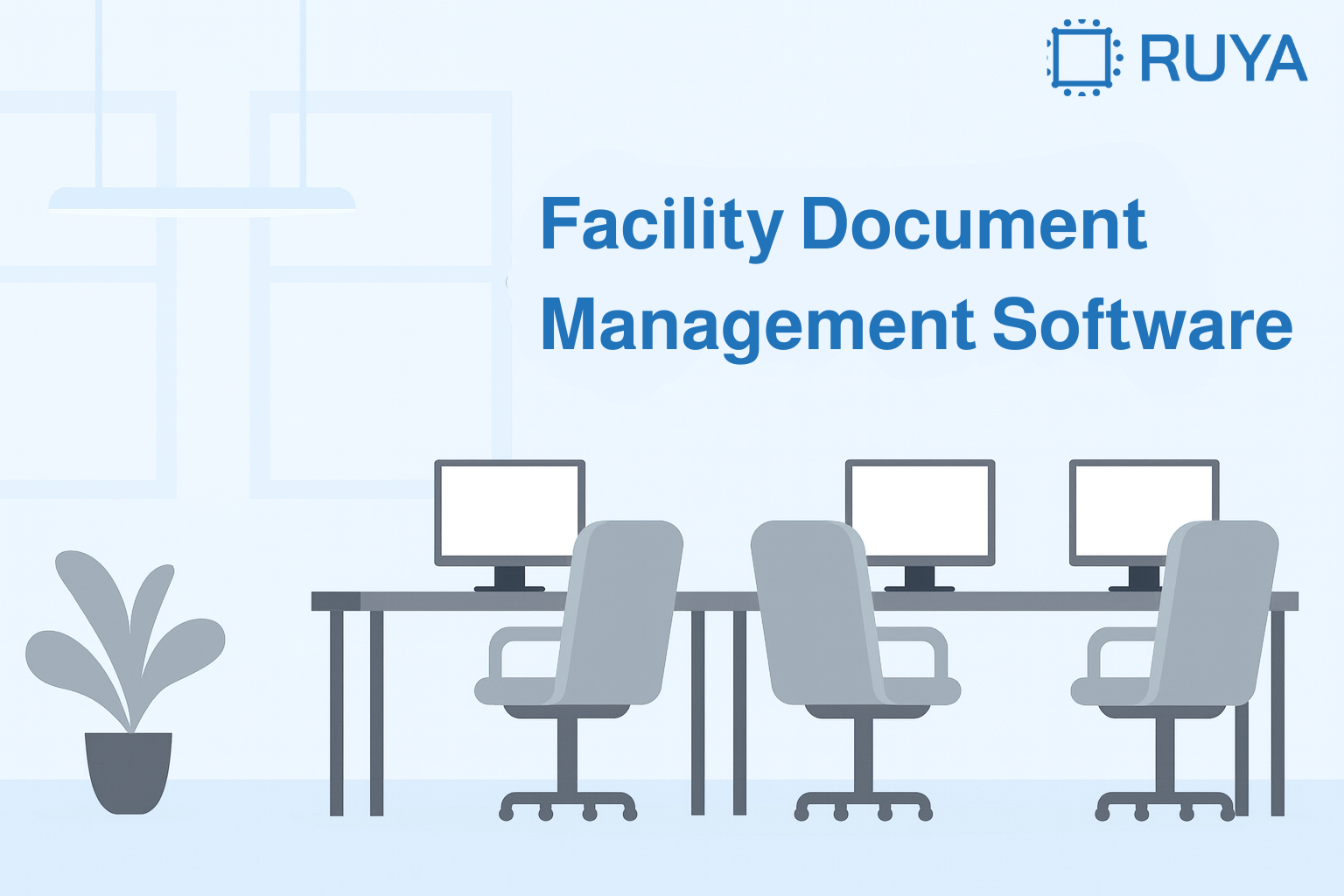What is facility management in hospitals? Our complete guide

Quick summary
Facility management in hospitals ensures that every part of a healthcare facility runs efficiently, safely, and in full compliance. This guide breaks down what facility management is in detail and key strategies like preventive maintenance, regulatory compliance, and space optimization that support better patient care and cost control. You’ll also learn how modern platforms like Ruya help hospitals enhance overall performance.
Is your hospital struggling to keep systems running smoothly?
Hospitals manage complex infrastructure and strict regulations that demand constant attention. Even small issues, like delayed maintenance or outdated floor plans, can disrupt operations and impact safety. Many facility teams face these challenges with limited visibility and disconnected tools.
In this Ruya article, we’ll explain what facility management in hospitals involves and why it’s essential for maintaining safe and efficient operations.
Why listen to us?
At Ruya, we simplify healthcare facility management with a mobile-first platform that centralizes floor plans, inspections, and vendor data. Our key features include real-time updates, mobile inspections, and life safety plan collaboration. Our platform is built specifically for healthcare facility teams managing multi-building portfolios, giving operations, compliance, and construction leaders visibility across every building in one place.
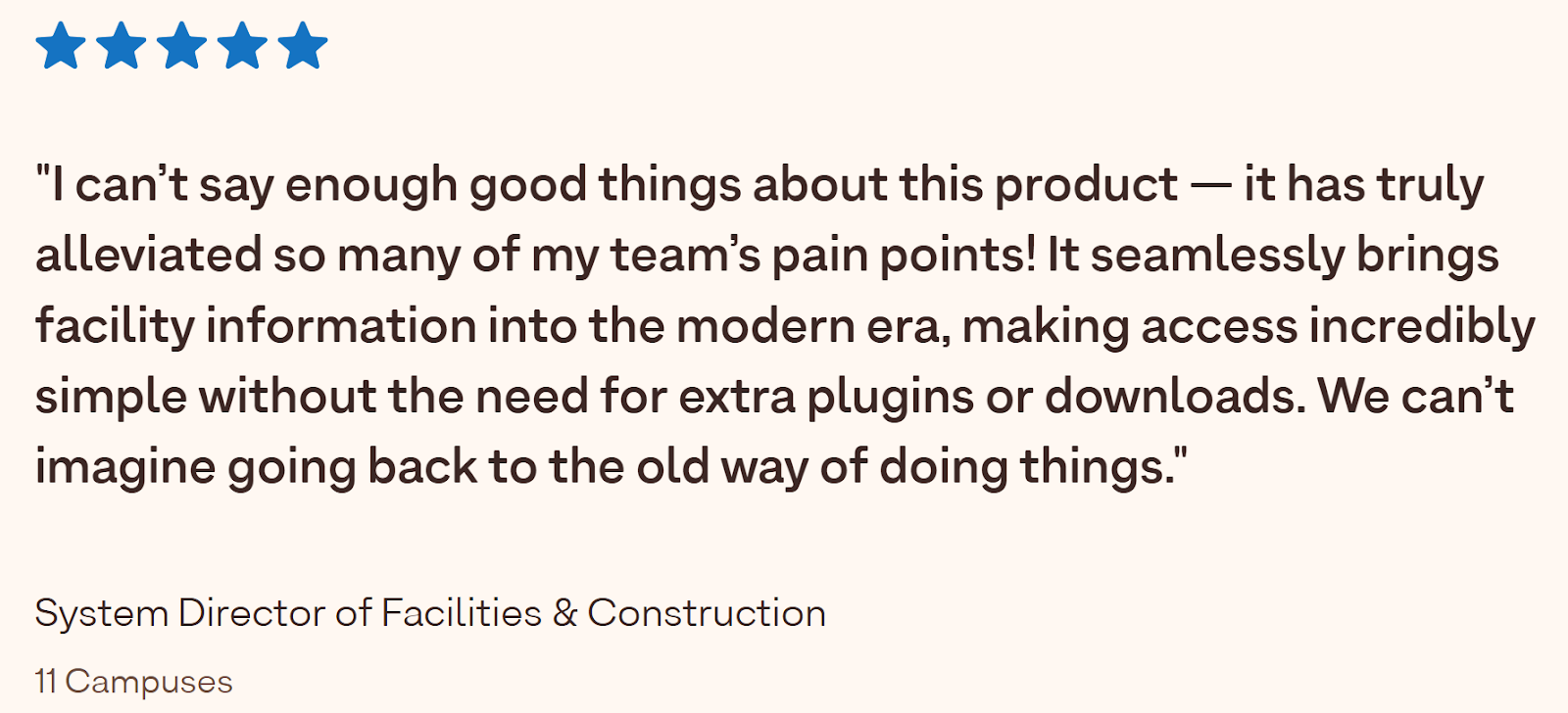
What is facility management in a hospital?
Facility management in a hospital ensures that every part of the infrastructure, including buildings, equipment, and systems, runs safely and efficiently. It covers asset management, regulatory compliance, and day-to-day operations, helping hospitals maintain high standards of care and safety.
Facility management in a hospital vs. a nursing home
Facility management in hospitals and nursing homes may share similarities but differ in key aspects. Here's a breakdown of their distinctions:
- Scope of work: Hospital facility management focuses on infrastructure maintenance, while nursing facility management centers on patient care and operational tasks in clinical settings.
- Compliance needs: Hospital facilities must adhere to strict building codes and safety regulations. Nursing facilities focus more on healthcare compliance, including patient safety and clinical practices.
- Technology use: Hospital facilities often use advanced systems for building management, while nursing homes rely more on patient management tools, such as electronic health records (EHR).
Facility management categories in hospitals
Facility management services are divided into hard and soft categories, each playing a vital role in hospital operations.
Hard facility management services
Hard services refer to the technical aspects of facility management, focusing on maintaining the physical infrastructure. These services make sure that essential systems are operational and meet safety standards, directly impacting the hospital’s functioning.
These systems include;
- HVAC Systems: Regular maintenance of heating, ventilation, and air conditioning systems to ensure comfort and air quality.
- Electrical Systems: Maintaining power supply and electrical circuits, so that all systems have reliable electricity.
- Plumbing: Regular inspections and repairs of plumbing systems to prevent leaks and maintain water flow.
- Fire Safety Systems: Making sure that fire alarms, sprinklers, and extinguishers are functioning correctly.
- Building Repairs: Routine maintenance of building structures, including walls, roofs, and floors.
- Elevators and Lifts: Regular inspections and servicing to ensure safe and efficient operation.
Soft facility management services
Soft services focus on non-technical aspects that affect daily hospital operations, staff, and patient safety. These services contribute to a clean, secure, and comfortable environment.
They include;
- Cleaning: Regular cleaning and sanitation of patient rooms, hallways, and public spaces.
- Waste Management: Handling of medical and non-medical waste for proper disposal and environmental safety.
- Security: Ensuring the safety of hospital staff and patients through surveillance, guards, and access control systems.
- Catering: Providing food services to patients, staff, and visitors.
- Pest Control: Monitoring and addressing any pest-related issues to ensure a safe environment.
- Landscaping: Managing outdoor spaces to maintain a welcoming and safe environment for visitors.
It’s not enough to focus on just one. Both services are important for maintaining hospital operations, patient care, and compliance with health regulations.
Functions of facility management in hospitals
- Maintenance of physical assets: Regular upkeep of building systems like HVAC, electrical, and plumbing ensures the hospital remains operational without interruptions. Preventive maintenance programs are necessary to avoid costly repairs and system failures.
- Compliance and regulatory management: Hospitals must meet strict health and safety standards. Facility managers ensure all systems, from fire alarms to waste management, comply with local and national regulations. This includes regular inspections and audits.
- Space management: Effective allocation and optimization of space are critical in hospitals. Facility managers track room usage, optimize facility layouts, and manage renovations to improve workflow and patient care.
- Vendor and asset management: Managing contracts, service providers, and equipment inventory helps streamline operations. Facility managers also ensure vendor performance aligns with hospital standards and minimizes downtime for critical equipment.
- Emergency preparedness and life safety: Facility management plays a key role in disaster preparedness, so that evacuation routes, fire suppression systems, and emergency equipment are regularly maintained and tested.
Benefits of facility management in hospitals
- Improved operational efficiency: Keeps essential systems, such as HVAC, plumbing, and electrical, running smoothly through preventive maintenance, optimized space use, and better resource allocation.
- Regulatory compliance: Helps hospitals meet strict health and safety standards set by agencies like OSHA, CDC, CMS, and The Joint Commission. Regular inspections, accurate documentation, and proactive maintenance keep facilities audit-ready and reduce the risk of penalties or violations.
- Cost savings: Prevents expensive emergency repairs and equipment replacements by focusing on routine maintenance and energy management. Efficient use of space, equipment, and utilities minimizes waste and extends the lifespan of hospital assets.
- Enhanced safety and reliability: Maintains safe environments for patients and staff by monitoring life safety systems, ensuring equipment performance, and preventing unexpected breakdowns.
- Data-driven decision-making: Centralized logs of inspections, repairs, and asset performance provide visibility into trends and operational gaps. This data empowers facility leaders to plan more effectively and make smarter long-term investments.
How to optimize facility management in hospitals
1. Implement preventive maintenance programs
Preventive maintenance is central to effective hospital facility management. Regular inspections help detect issues early, avoiding costly repairs and unexpected system failures. This proactive approach keeps equipment running efficiently.
To build a data-driven maintenance program, hospitals can focus on the following:
- Use data for scheduling: Leverage asset data such as age, usage, and manufacturer guidelines to plan maintenance. Condition-based scheduling helps predict failures before they occur and ensures timely interventions.
- Leverage technology for real-time monitoring: With systems like Ruya, mobile inspections with built-in code checklists provide live, field-based data capture and syncing through integrated CMMS or IoT devices. This enables facilities teams to identify maintenance needs on-site as they happen. This real-time visibility, similar to a centralized dashboard view of building systems, improves response time and reduces risk.
- Automate maintenance triggers: Our rule-based automation tools let facilities teams schedule tasks automatically based on inspection results, like assigning work orders when issues are flagged or triggering alerts for upcoming warranty expirations. These smart workflows make sure that maintenance happens on time without manual tracking.
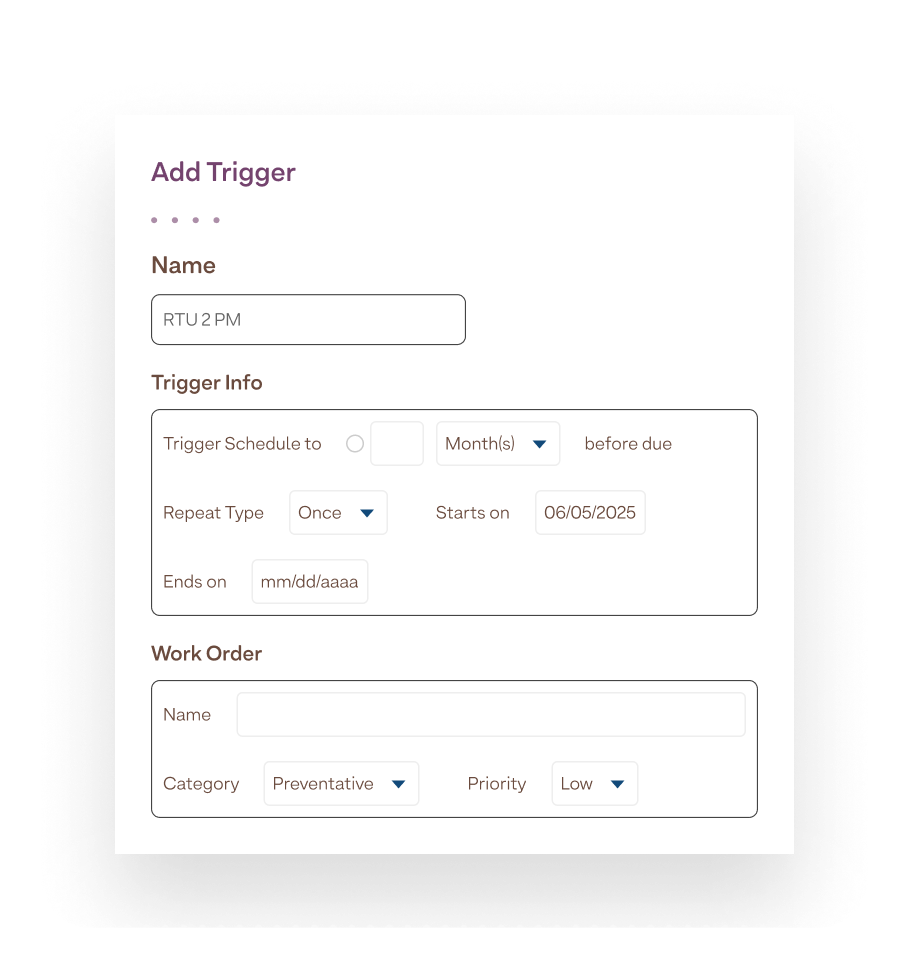
- Track asset health: Digital records provide a live view of each asset’s condition. Real-time updates help staff manage maintenance efficiently and prevent service disruptions.
2. Streamline compliance management
Strong compliance management protects hospitals from penalties and ensures safety standards are met across every building. Streamlining these processes helps teams stay audit-ready and maintain regulatory compliance with less manual effort.
To simplify compliance, hospitals can adopt these strategies:
- Automate documentation: Use tools like Ruya to automatically log inspections, maintenance tasks, and compliance checks. This prevents missed deadlines and keeps required records organized and accessible. To learn more about documentation, read our guide on document control systems.
- Centralize compliance data: Store key information, such as vendor contracts, asset inspections, and certifications, in one system. Ruya’s asset directory organizes this data per building, making it easier to manage and update.
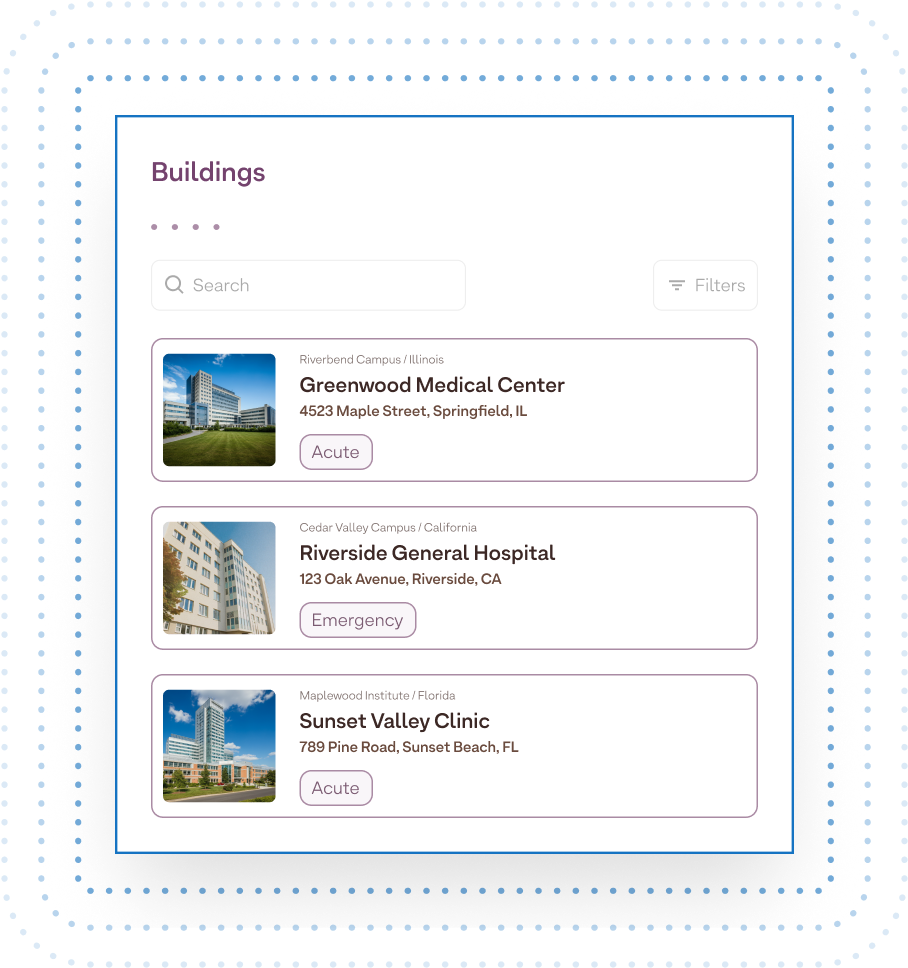
- Enable real-time updates: With live syncing across floor plans, inspection statuses, and building systems, Ruya keeps life safety plans current and aligned with regulations. Continuous updates ensure field data is instantly reflected across teams, reducing lag and audit risks.
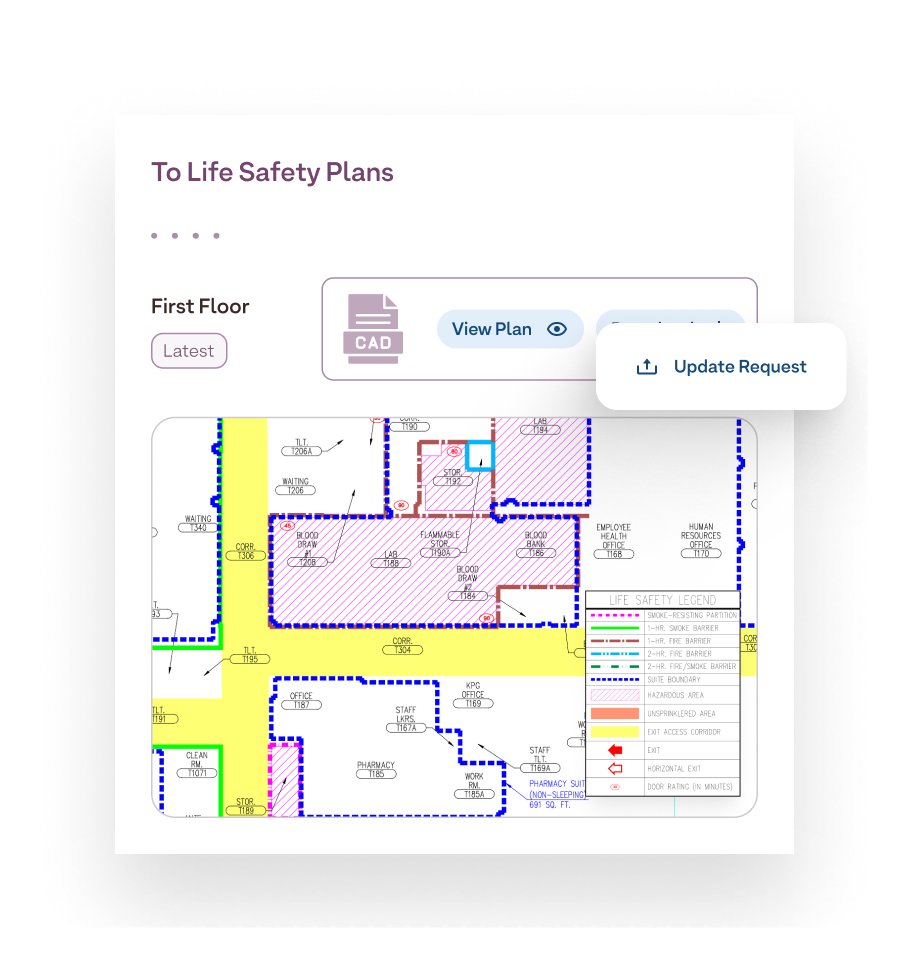
3. Optimize space and resource use
Efficient space and resource management help hospitals operate at full capacity. When areas are used effectively, hospitals reduce costs, improve workflows, and enhance patient care across departments.
To make the most of available space and resources, hospitals can:
- Track space usage: Use data to monitor how each area is utilized. With Ruya’s real-time floor plan updates, facility teams can analyze usage patterns and ensure every room supports patient care or essential operations.

- Reallocate underused areas: Identify and repurpose low-traffic spaces for higher-impact needs, like converting administrative offices into treatment rooms or specialized clinics. Real-time insights reduce unnecessary expansions and renovation costs.
- Optimize resource allocation: Monitor equipment usage across departments to confirm optimal performance and availability. Our asset management tools help teams track assets in real time, preventing underuse and ensuring critical tools remain accessible.

- Improve energy efficiency: Managing energy use is part of effective space planning. By identifying underused zones and adjusting lighting, HVAC, or cooling systems, hospitals can cut unnecessary energy expenses.
4. Strengthen collaboration and visibility
Hospitals function like complex ecosystems, where facility, operations, and compliance teams manage interconnected responsibilities. When communication breaks down, it causes delays, duplication, and safety risks.
Strong collaboration aligns teams around shared goals, while clear visibility keeps decisions grounded in real data, not assumptions. With real-time insight into maintenance schedules and compliance updates, leaders can spot issues sooner and coordinate things faster.
Here’s how hospitals can strengthen teamwork and oversight:
- Centralize facility data: Consolidate information, such as floor plans, inspection reports, and asset records, into one unified platform. With Ruya, every stakeholder accesses the same real-time data, reducing miscommunication and duplication of effort.
- Enable cross-department access: Give teams, from compliance officers to maintenance staff, shared visibility into systems and updates fosters accountability. Everyone stays informed, whether they’re on-site or remote.
- Use visual dashboards: Ruya’s integrated dashboards provide a clear, real-time view of building systems, active work orders, and inspection statuses. This visibility helps leaders prioritize tasks, monitor performance, and identify risks early.
- Offline collaboration tools: Even without network access, Ruya’s life safety plan collaboration keeps teams synchronized, ensuring updates are captured and shared once reconnected.
5. Reduce IT reliance
Many hospitals depend on complex IT systems to manage facilities, which can create bottlenecks and slow down operations. Reducing this dependence allows facility teams to work more autonomously and respond faster to emerging issues.
To simplify infrastructure and improve agility, hospitals can:
- Adopt cloud-based tools: Platforms like Ruya eliminate the need for heavy IT setups. With a secure, mobile-first design, teams can access data, inspections, and floor plans from anywhere, without waiting on internal IT support.
- Enable no-code workflows: Simple automation tools let staff schedule tasks, trigger alerts, and assign work orders without technical support, saving time and reducing IT workload.
- Streamline integrations: Connecting existing systems, such as CMMS or BMS, through modern interfaces ensures data continuity without custom development or costly maintenance.
- Minimize hardware dependency: Mobile access reduces the need for specialized hardware or on-premise servers, allowing teams to manage operations directly in the field.
Optimize your hospital’s facility management with Ruya
Managing a hospital’s facilities involves keeping systems reliable, environments safe, and operations fully compliant. Without structured processes and real-time visibility, even small gaps in inspections, records, or updates can disrupt patient care and raise compliance risks.
Ruya simplifies facility management by bringing everything into one connected platform. From mobile inspections and code-based checklists to real-time floor plans and vendor directories, our platform helps hospitals track performance, close gaps faster, and stay survey-ready across every building.
Book a demo today to see how Ruya can transform your facility management workflows.

.svg)
